Cancer is a disease in which cells multiply wildly, destroy healthy tissue, and endanger life. About 100 kinds of cancer occur in people. The major characteristic of cancer cells is they are essentially immortal. Unlike normal cells which are born and then die, cancer cells, once born, are capable of living and multiplying indefinitely. Another feature of cancer cells is their ability to travel to other parts of the body and continue to grow there. This process is called metastasis.
Cancer strikes people of all ages but is most common in the middle-aged and the elderly. The disease is a leading cause of death in many countries. Cancer occurs about equally in males and females. The disease can attack any part of the body and may spread to other parts. Cancer occurs in most other animals as well as in people.
Without proper treatment, most kinds of cancer are fatal. However, some small cancers are found incidentally by doctors. These cancers may grow slowly and may never cause harm to the patient during his or her lifetime. Methods of diagnosing and treating the disease have improved greatly. About half of all cancer patients now survive at least five years after treatment. People who remain free of cancer during that time have a good chance of remaining permanently free of the disease.
More research is needed to find even better methods of curing cancer. Because cancer affects so many people, many countries spend public money to fund cancer research. The study of the development, treatment, and prevention of cancer is called oncology. It includes both research and clinical care. Physicians who specialize in oncology are known as oncologists.
Major types of cancer
Cancers that affect human beings are classified in two ways: (1) by primary body site—that is, the part of the body where cancer first develops; and (2) by the type of tissue in which the cancer originates.
Classification by primary body site.
Cancer first appears most often in the skin, the female breasts, and the organs of the digestive, respiratory, reproductive, blood-forming, lymphatic, and urinary systems. The number of cases of cancer in these sites varies from country to country. Cancer of the stomach, for example, is much more common in Japan than in the United States or India. Rates of breast cancer are high in the United States and the United Kingdom, but much lower in India and many Asian countries. Scientists are conducting research to understand these differences and how diet and exposure to pollutants may be responsible. The following discussion deals with the kinds of cancer that occur most often in many countries.
Skin cancer
is the most common type of cancer in the world. Most skin cancers grow slowly and do not spread to other parts of the body. As a result, these cancers are among the easiest to cure. Most people treated for skin cancer recover completely. However, one form of skin cancer called malignant melanoma is particularly dangerous. This type of cancer begins in the skin’s pigment cells. If not detected and treated early, it can spread rapidly to other parts of the body.
Breast cancer
occurs in both sexes, but it attacks women about 100 times more often than it strikes men. Most of these cancers occur in women over 40 years of age. Female breast cancer patients whose disease is found and treated before it has spread beyond the breast have good long-term survival rates. 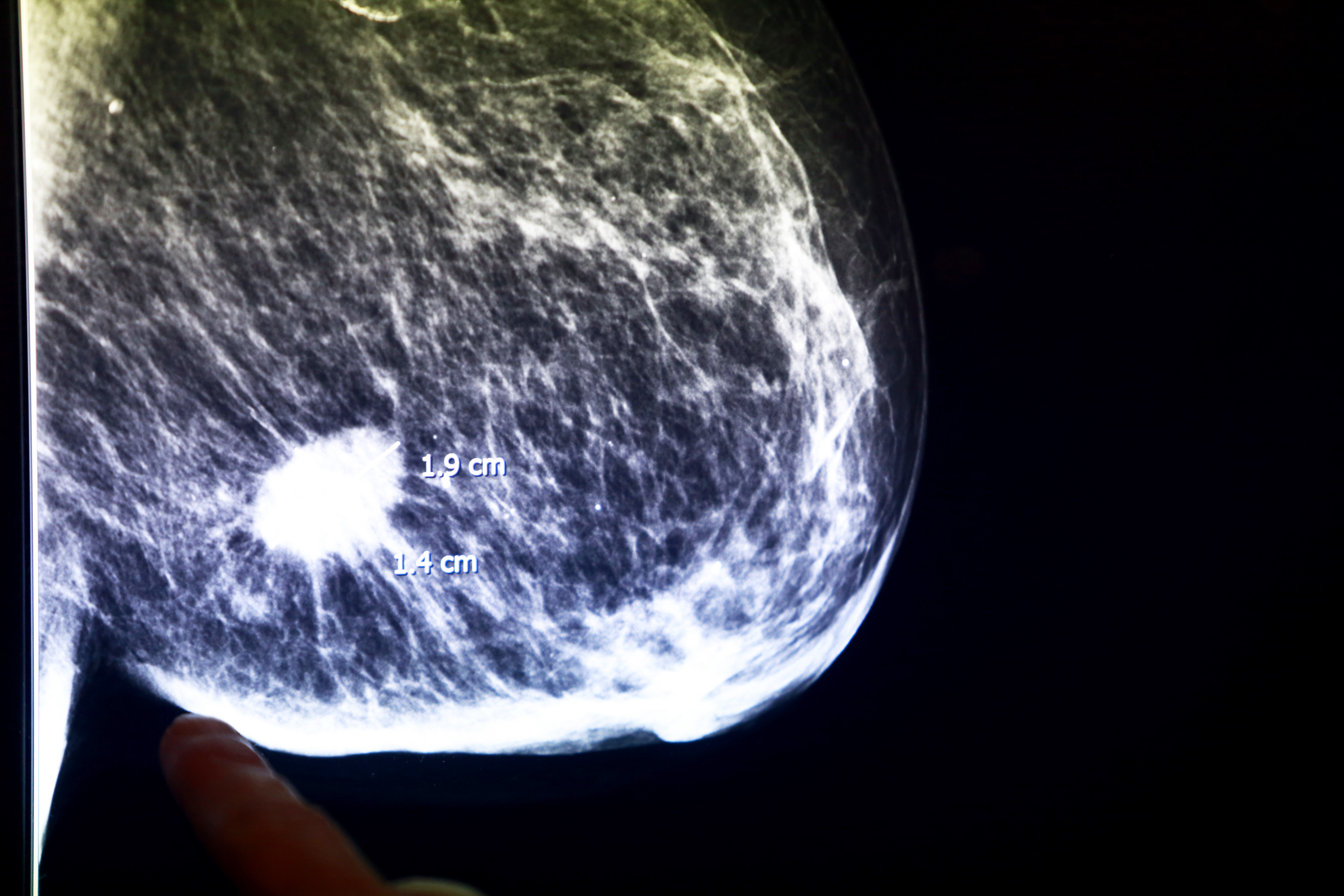
Lung cancer
in most industrial countries kills more people each year than any other kind of cancer. The death rate is high because many lung cancers have spread to other body sites before they are detected.
Head and neck cancers
are cancers that arise from anatomic structures in the head and neck area such as the larynx, tonsils, salivary glands, tongue, the pharynx, and the sinuses. They may be associated with a history of tobacco smoking or chewing or they may be caused by certain viruses.
Central nervous system tumors
may arise from the cells that make up the brain and spinal cord, such as astrocytoma or glioblastoma, or from the surrounding membranes of the brain, called meningioma. Certain cancers, such as lung and breast cancers can spread to the brain. However, this is not the same as primary (arising from) brain cancer.
Gastrointestinal cancer
includes all cancers of the digestive organs. The most commonly affect the parts of the large intestine called the colon and the rectum. About half of all people treated for cancer of the colon or rectum survive five years or longer after treatment with no return of the disease. Other digestive organs commonly affected by cancer include the esophagus, liver, pancreas, and stomach. 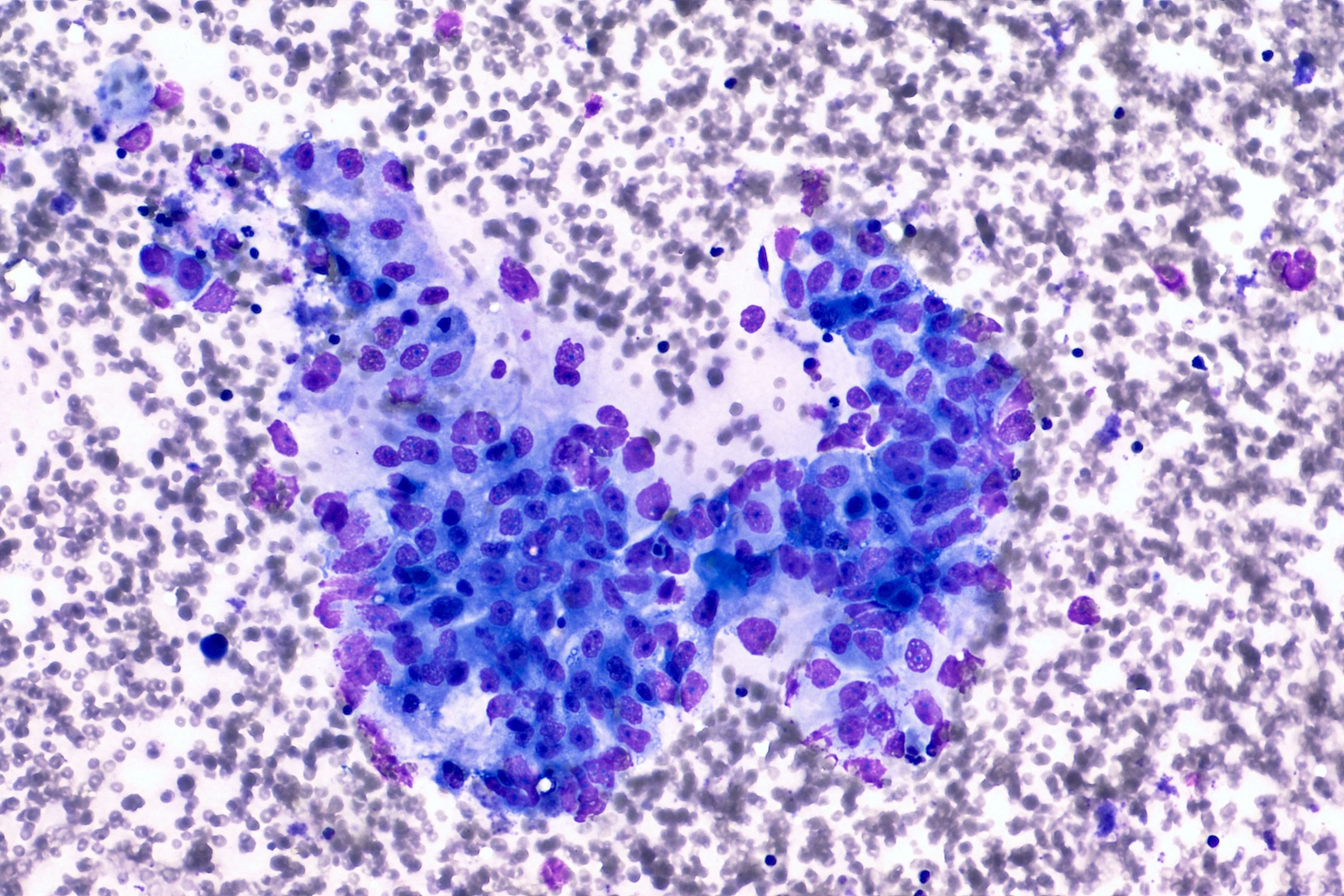
Genitourinary cancers
include cancers of the organs of the urinary and reproductive systems. They are relatively common among both men and women. The bladder is the urinary organ most commonly affected by cancer. The majority of bladder cancer patients are men, and most survive five years. Many such cancers are detected early because they arise in the inner layer of the bladder and cause bleeding in the urine.
The male organ most often affected is a small gland called the prostate. Most cases occur in men over 50 years old. Proper treatment can cure the disease in its early stages and control more advanced prostate cancer for many years. Among young men, cancer of the testicle is a common form of cancer. Testicular cancer is highly curable, even when the cancer has spread to other parts of the body.
Gynecological cancers.
The most common cancers of the female reproductive system affect the uterus, the organ in which babies develop. Some cancers arise in the main part of the uterus. Cancer may also affect the lower, necklike part of the organ called the cervix. Cancer of the cervix strikes more younger women than do other cancers of the uterus. Cancer of the ovary is less common. However, it is often associated with certain genetic patterns, and it can run in families.
Classification by tissue.
Scientists group cancers based on the body tissue in which tumors begin. Carcinomas develop in epithelial tissue, which forms the outer layer of skin and lines internal body surfaces and organs. Many organs, including the breast, colon, and lung, also contain glands. Cancers that arise in gland tissue, called adenocarcinomas, are among the most common cancers.
Leukemias
are cancers of the bone marrow and other blood-forming organs. In leukemia, immature white blood cells multiply wildly and interfere with production of other vital blood elements.
Multiple myeloma
is a cancer that forms in plasma cells, a type of white blood cell. Plasma cells produce proteins called antibodies that fight infection. In multiple myeloma, cancerous cells accumulate in the bone marrow, where they crowd out healthy blood cells. Rather than produce helpful antibodies, the cancer cells produce abnormal proteins that do not function properly.
Sarcoma
is cancer that develops in connective tissue. Connective tissue forms the body’s supporting structures, such as bones and cartilage. Sarcomas also form in the breast, digestive system, respiratory system, and reproductive system, but far less often than carcinomas.
Cancer in children,
called pediatric cancer, differs from adult cancer in several ways. Cancers common in adults, such as those that occur in the lungs, breasts, prostate, or colon do not usually occur in children. The common types of cancer that strike children include neuroblastoma, which arises in nervous tissue; retinoblastoma, which develops in the eyes; nephroblastoma, also called Wilms tumor, which occurs in the kidneys; rhabdomyosarcoma, which arises from soft tissues; and osteogenic sarcoma and Ewing’s sarcoma, which develop in the bones. These cancers are extremely rare in adults.
The emotional impact on the family and physical and emotional consequences to the child are important considerations in the treatment of pediatric cancer. Fortunately, many of these cancers and leukemias are highly curable, and many children survive to lead normal lives following treatment. However, the treatment of pediatric cancer may have long-term consequences for patients as they live out normal life spans. For example, radiation therapy and chemotherapy (drug therapy) can actually cause secondary cancers, including leukemia, years after treatment has been completed. Other long-term consequences of cancer treatment may include stunted growth and infertility later in life.
Molecular biology of cancer
Scientists have greatly increased their knowledge of how cancer develops. The cells of all living things contain genes that direct cell growth and reproduction. The instructions are chemically coded in long coils of a substance called DNA (deoxyribonucleic acid). Particular sections of DNA make up genes that control specific cell functions. DNA even contains genes that enable the molecule to repair itself. But as people grow older, damage can build up and destroy DNA’s ability to repair itself.
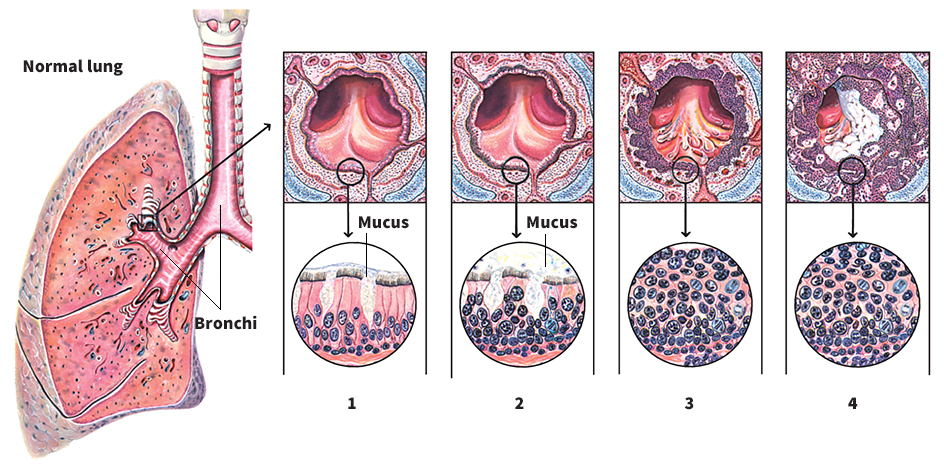
Cancer arises when certain genes become damaged and cells multiply without control. The damaged genes may instruct the cell to divide in an abnormal fashion. Other genes may lose the ability to instruct the cell that it can no longer function and must die. Some damaged genes are changed in ways that enable cancer cells to invade healthy tissue, grow new blood vessels to nourish themselves, or spread to other parts of the body.
Some types of abnormalities in genes are inherited. Substances in the environment can also damage genes. A substance that damages genes in a way that can lead to cancer is called a carcinogen. Many substances found in nature, both natural and artificial, are carcinogens. The most well-known carcinogen is cigarette smoke and the many chemicals that are found in cigarette smoke.
Cancer often results from damage to the genes that control cell growth and division. Two important classes of these genes are called proto-oncogenes and suppressor genes. Proto-oncogenes promote cell growth or division. Damage to a proto-oncogene may transform it into an overactive form called an oncogene. Oncogenes can lead to cancer by directing a cell to multiply excessively and spread to other parts of the body. They also enable cancer cells to resist the effects of drugs that are designed to eliminate them—a process called drug resistance. Scientists have identified dozens of oncogenes that contribute to cancers in many sites, including the bladder, breasts, liver, lungs, and colon.
Suppressor genes limit cell growth or division. Damage to a suppressor gene can lead to cancer by destroying that gene’s ability to stop cell multiplication.
Scientists think most cancers involve transformation of many proto-oncogenes into oncogenes and inactivation of a number of suppressor genes. In most cases, genetic damage must accumulate for years before a cell becomes cancerous. Once cancer occurs, the disorganized, rapidly dividing cells gradually build up into a mass that compresses and destroys nearby tissue.
As the cancer grows, cells can break away and travel through blood or lymph (fluid from body tissues) to invade other parts of the body in a process called metastasis. The likelihood of curing cancer drops sharply once the cancer has spread. However, some cancers can be well controlled for years, and patients can live nearly normal lives even after a cancer has spread.
People acquire the genetic damage that can lead to cancer in two main ways: (1) by inheriting damaged genes, called familial cancers; and (2) through exposure to carcinogens in the environment that damage genes.
Familial cancers.
Scientists have long known that the risk of some cancers increases for people with close relatives who also have the disease. This increased risk occurs because some types of genetic damage involved in cancer can be passed from parents to children. But most cancers require multiple injuries to DNA. Inherited damage to one gene thus raises risk but does not guarantee that any particular individual will develop cancer. Scientists have identified the inheritable genetic damage involved in certain forms of breast, colon, and other cancers. Researchers are working to learn much more about inherited cancer genetics. They hope their knowledge will lead to new strategies for preventing and treating cancer.
Carcinogens.
Most people who develop cancer do not have inherited genetic abnormalities. Their genes are damaged after birth by carcinogens in their environment.
Once a carcinogen damages a cell’s DNA, the damage can be passed on to new cells that arise from division of the damaged cell. The changes are thus passed on to all the cell’s descendants. Meanwhile, the descendant cells can acquire additional DNA damage that is also passed along. Experts think many cancers arise from such combined effects of several carcinogens.
Three classes of carcinogens in human beings are (1) chemicals, (2) certain forms of radiation, and (3) viruses.
Chemicals.
Scientists have identified many chemicals that can cause cancer in animals. These chemicals may also pose a cancer hazard to human beings. For example, cigarette smoke contains more than 4,000 chemical substances, of which dozens have been identified by scientists as carcinogens.
Some industrial chemicals create a cancer hazard for people who work with them. Such chemicals include aniline dyes, arsenic, asbestos, benzene, chromium, nickel, vinyl chloride, and certain products of coal, lignite, oil shale, and petroleum. Scientists work continuously to find chemicals that pose occupational cancer risks.
Some substances that are added or applied to foods are also suspected of causing cancer in human beings. These substances include some chemicals used to control weeds and some that are used to kill insects. Molds that sometimes develop on such food crops as corn and peanuts may also contain carcinogens. The mold can be controlled through proper storage and handling of crops.
Radiation.
Certain kinds of radiation can disrupt DNA and lead to cancer. X rays are a cancer hazard in large doses. However, doctors do not believe that routine medical and dental X rays pose a significant danger. A form of nuclear radiation known as ionizing radiation can also cause cancer. For example, in 1986, when Ukraine was part of the Soviet Union, a nuclear reactor at a power plant in Chernobyl (now Chornobyl) exploded. Children who were exposed to radioactive fallout from that explosion experienced an increased rate of thyroid cancer.
Viruses.
Experiments have shown that certain kinds of viruses cause cancer in animals. Some viruses can also cause cancer in people. For example, the human papillomavirus (HPV) causes most cases of cervical cancer. Another virus has been linked to a rare form of leukemia, and some forms of liver cancer may be caused by viruses. However, most experts feel that viruses are not a major cause of human cancers.
Cancer prevention
Scientists know that many cancers are familial. These cancers have a genetic cause that limits the ability to prevent the disease. However, scientists have identified several factors that can increase a person’s chances of developing cancer. Many scientists believe that people can decrease their overall chances of developing cancer by adopting a healthy lifestyle and avoiding contact with known carcinogens.
Avoiding carcinogens.
Smoking is one of the most widespread and avoidable environmental causes of cancer. Scientists think that smoking causes about one-third of all cases of cancer, including most lung cancers. Smoking also causes many cancers of the mouth, larynx, trachea, esophagus, pancreas, kidney, bladder, and cervix. Cigarette smoke can even cause cancer in nonsmokers who live or work closely with smokers. Smokers who quit can significantly reduce their chance of developing lung cancer.
People can also reduce their risk of developing skin cancer. The sun is one of the most important sources of cancer-causing radiation. Most cases of skin cancer—including deadly melanoma—are caused by an invisible portion of the sun’s radiation called ultraviolet rays. Physicians advise against sunbathing and recommend that people who work outdoors wear protective clothing or apply sunscreens that block ultraviolet rays.
Scientists know that the human papillomavirus causes most cases of cervical cancer. In 2006, the United States Food and Drug Administration approved a vaccine that is highly effective against HPV and can prevent cervical cancer caused by the virus. The U.S. Centers for Disease Control and Prevention recommends HPV vaccination for all girls by ages 11 or 12.
Nutrition.
Some chemicals naturally present in food may become a cancer threat if consumed in large quantities. Diets high in fats, for example, have been associated with cancers of the breast, colon, and prostate gland. Some studies have linked eating large amounts of salt-cured, salt-pickled, and smoked foods to cancers of the digestive system. Excessive alcohol consumption has been linked to cancer of the mouth, pharynx, larynx, esophagus, and liver.
Many scientists believe that certain foods contain substances that may help prevent cancers in people. Such foods include broccoli, cauliflower, cabbage, spinach, tomatoes, carrots, fruits, and whole-grain breads or cereals.
Cancer detection and diagnosis
Only a doctor can diagnose cancer. But in many cases, people consult a doctor only after the disease is far advanced. A person should therefore be alert to any physical change that may be a symptom of cancer. Detecting cancer while a tumor is small and confined to one location greatly increases the chances of a cure. However, even when a cancer is initially diagnosed and is small, metastases may have already occurred.
Cancer checkups.
Many cancers cause no symptoms in their early stages. To detect early cancers, the American Cancer Society recommends that people aged 20 to 40 have a cancer-related checkup by a physician every 3 years. People aged 40 or older should have a checkup every year. A cancer-related checkup usually includes a physical examination. Physicians watch carefully for any visible signs of cancer when they perform physical examinations.
Depending on the patient, screening tests for specific types of cancer may also be performed. Screening tests may include a breast X ray called a mammogram to detect breast cancer in women. A mammogram can detect some breast cancers before any lumps can be felt.
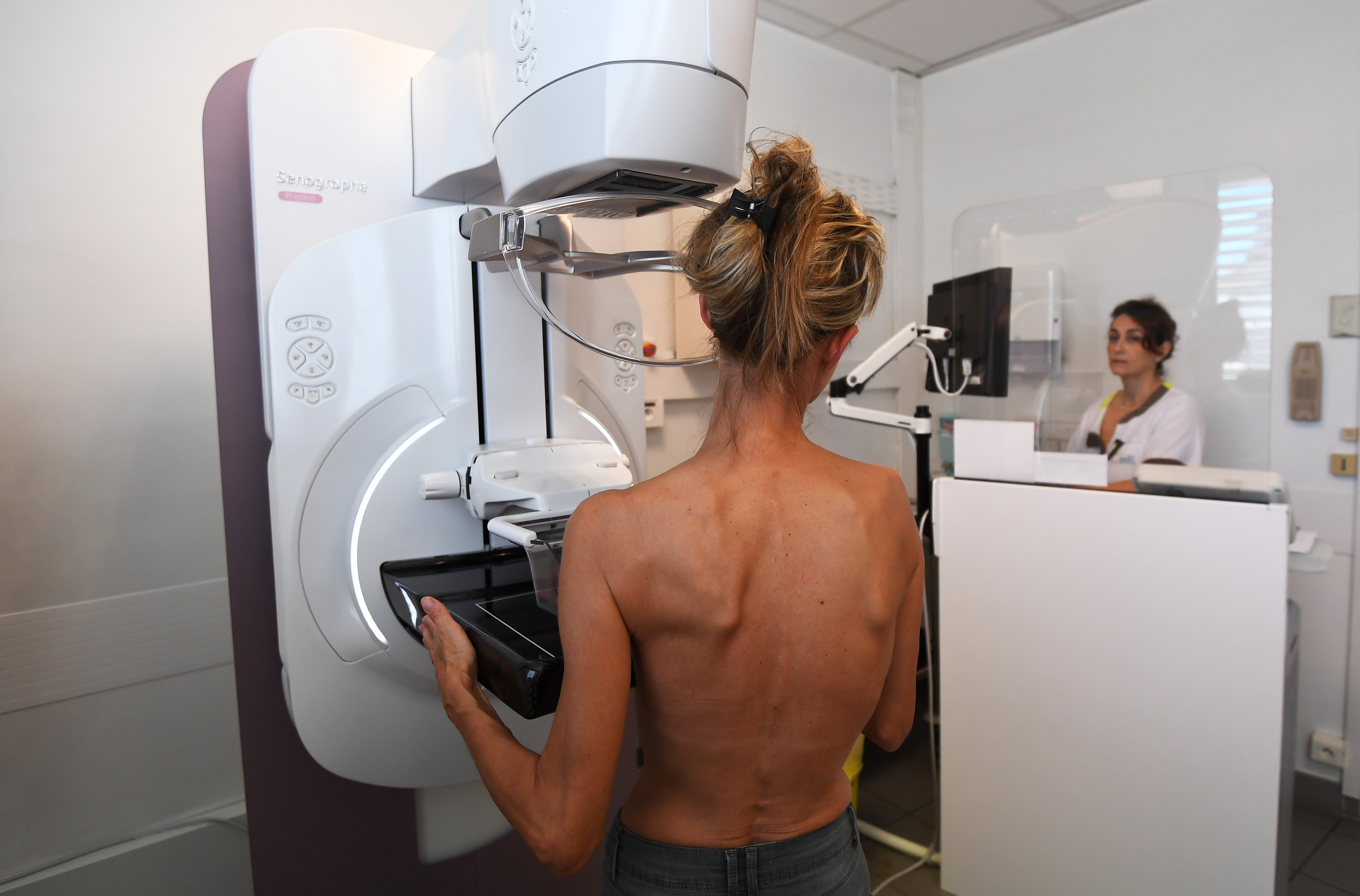
Physicians recommend that beginning at age 50, patients have routine tests for colon cancer. In one such test, called a fecal occult blood test (FOBT), the patient uses special kit to collect tiny samples of stool (solid body wastes). Laboratories test the samples for microscopic amounts of blood, which may indicate cancer.
A blood test for a protein called prostate-specific antigen (PSA) may detect early prostate cancer. PSA is made only in the prostate gland. Elevated levels of the protein may mean that the gland has become cancerous.
Preliminary diagnosis
identifies a suspicious mass or other change in the body that requires further investigation. Some symptoms must be evaluated with special X rays and other advanced imaging techniques. One X-ray technique, called computed tomography or CT scan, can reveal suspicious masses in such internal organs as the brain and the lungs. A technique called magnetic resonance imaging (MRI) uses magnetic fields and radio waves to produce images of internal organs. These imaging techniques allow physicians to determine the exact location, size, and shape of cancer tumors and determine whether the cancer has spread.
Conclusive diagnosis.
The various methods of preliminary diagnosis may reveal the presence of a tumor. But not all tumors are cancerous. Most lumps in the breast, for example, are benign (noncancerous). Doctors need to perform a test called a biopsy to make a definite diagnosis of cancer. In a biopsy, doctors remove a small piece of tissue from the tumor. In suspected cases of leukemia, they take a blood sample or remove tissue from a blood-forming organ. Experts then examine the tissue under a microscope to check for cancer cells.
Staging.
Physicians use a process called staging to describe how a particular cancer in a patient has advanced. Staging is important in helping physicians decide which treatments are most likely to be successful in treating the cancer. The most common staging method is known as the TNM system. This system describes the tumor (T), whether the cancer has invaded lymph nodes (N), and whether there are any metastases (M). Physicians determine the staging level through physical examination, X rays, CT scans, and other specialized tests.
Since each type of cancer is different, there are different staging categories for each cancer. If cancer is discovered in the early stages, the cancer treatment may be successful. Advanced stage cancers are more difficult to treat. If tests show that the cancer has spread, patients may need to undergo additional treatments.
In addition to the TNM classification, new forms of cancer identification determine what mutations are present in a patient’s cancer cells. Certain treatments have been developed that are based upon the specific mutation present rather than the area of the body or tissue is involved with the cancer.
Cancer treatment
Cancer has a highly emotional impact on the patient who is diagnosed with the disease, and on his or her family. Most health care providers in the United States try to provide substantial medical and nonmedical support for both the patient and family. Many health care providers have developed comprehensive cancer centers to provide expert management of patients with cancer. The centers provide resources and information for both patients and the physicians treating them.
Methods for treating cancer include surgery; radiation therapy; and chemotherapy. Most cancer treatment plans combine several or all of these methods in a technique called multimodality therapy. In the most common multimodality therapy, doctors prescribe drug therapy to follow surgery, radiotherapy, or both of those treatments. Such follow-up treatment is called adjuvant drug therapy.
Surgery
is the main method of treating most types of cancer. Cancer surgery chiefly involves taking out the tumor while minimizing the removal of healthy surrounding tissue. Surgeons work closely with a pathologist (expert on tissue changes) who can examine tissue during the surgery to determine if the tumor has been completely removed.
Radiation therapy,
also called radiotherapy, attacks cancer cells with X rays or other high-energy particles from radioactive substances. Radiotherapy is often used to treat cancers of the bladder, prostate, head, and neck. Radiation kills cancer cells, but it also kills normal cells.
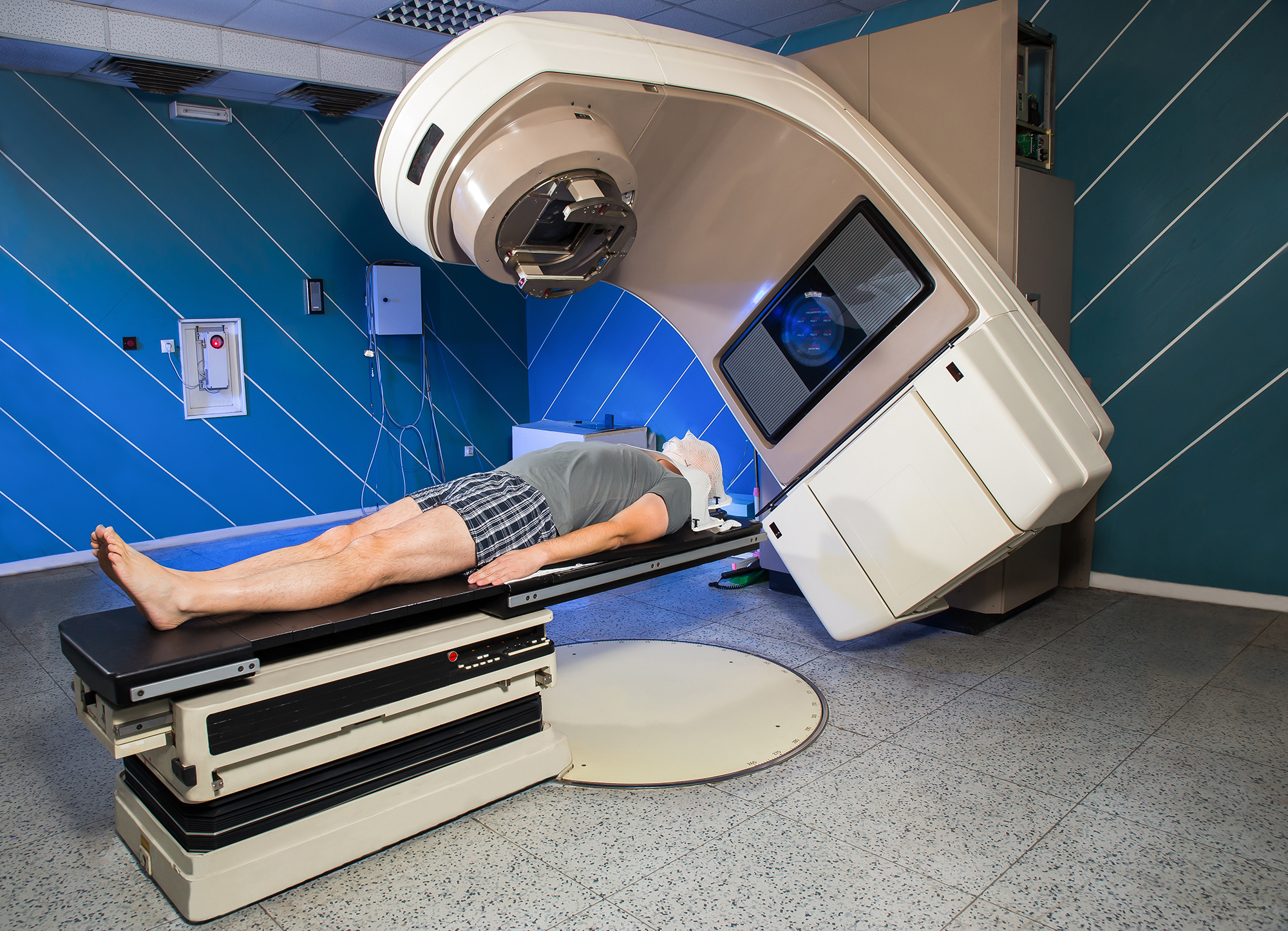
One type of radiotherapy, called external beam radiotherapy, sends X rays into the target tissue to destroy cancer cells. Machines called linear accelerators produce the X rays at increasingly greater energy. The higher the energy of the X rays, the deeper the beam can penetrate into the body to reach cancer tumors. Improved methods to focus the radiation beam prevent radiation damage to normal tissues surrounding the cancer that is being treated.
Physicians use CT scans and MRI to determine the exact size and shape of a cancerous tumor. In a technique called three-dimensional conformal radiation therapy, or intensity modulated radiation therapy, the radiation beam is shaped to exactly match the cancerous tumor. Physicians can then deliver a high dose of radiation to the tumor with little radiation exposure to healthy tissue. A technique called stereotactic radiosurgery is often used to treat cancer tumors located in the brain that cannot be removed through conventional surgery.
Brachytherapy
is often used to treat cancers of the prostate and brain. In this type of radiotherapy, radiation comes from small capsules, called seeds, of radioactive material implanted by a surgeon close to, or within, the cancer tumor. The radiation only penetrates a short distance, so nearby healthy tissue is usually not harmed while the cancerous cells are killed.
Chemotherapy
is used against a wide variety of cancers. Chemotherapy drugs have proved especially effective in treating breast cancer, colon cancer, leukemia, lymphoma, and testicular cancer. Cancer cells divide much more rapidly than normal cells. Therefore, many chemotherapy drugs are designed to interfere with cell division.
Chemotherapy causes side effects by injuring the normal body cells, especially those that divide most rapidly. Rapidly dividing normal cells include blood-forming cells, cells that line the intestines, and hair-forming cells. Damage to blood-forming cells may increase a patient’s risk of developing anemia or an infection. Injury to intestinal cells may cause nausea and vomiting. Disruption of hair-forming cells can cause hair loss. Researchers work constantly to develop drugs that reduce harm to normal cells.
Effective chemotherapy usually involves combinations of drugs. Doctors combine drugs that have different methods of acting on cancer cells and that produce different side effects. Combination therapy reduces the chance that cancer cells will develop resistance to the drugs. It also helps avoid serious side effects from large doses of a single drug.
Other cancer treatments.
As scientists continue progress toward understanding the molecular basis of cancer, they are developing new treatments. Many promising new treatments take advantage of the molecular biology of cancer to kill cancer cells while leaving other cells healthy.
Hormonal therapy.
Some cancers require certain chemicals in the body, such as the hormones testosterone and estrogen to enable their growth. Hormones act as act as “chemical messengers” that help different parts of the body function in a coordinated way. Hormonal therapy is designed to interfere with the hormones that cancer cells need to grow. This therapy is most common for treating prostate and breast cancers.
Biological response modifiers
increase a person’s ability to fight cancer by strengthening natural body processes. Other biological modifiers improve the body’s ability to withstand aggressive drug therapy.
Immunotherapy.
Some biological modifiers are immunotherapies—that is, they stimulate the body’s immune system to recognize and attack cancer cells. Scientists have made great progress developing drugs in this new field, also called immune-oncology. In 2017, the FDA approved a new treatment that uses a patient’s own immune system cells to fight a deadly form of leukemia.
An important part of the immune system is its ability to tell between normal cells in the body and abnormal cancer cells. To do this, the immune system recognizes certain molecules called “checkpoint proteins” to identify a healthy cell. Cancer cells often use checkpoint molecules to evade an attack by the immune system. A new class of drugs, called checkpoint inhibitors, blocks these proteins on cancer cells. The patient’s immune system can then attack, and in many cases, eliminate the cancer.
Monoclonal antibodies are an important type of immunotherapy. They are designed to recognize certain proteins that are found on the surface of some cancer cells. The monoclonal antibody then binds onto the protein. This action then triggers the body’s immune system to attack the cancer cells and can also cause the cells to destroy themselves.
For example, about one-third of breast cancer patients have high levels of a protein called HER2 on the surface of the cancer cells. Scientists have developed a monoclonal antibody that binds onto this protein and stops the cancer cell from growing and dividing. The antibody also causes the body’s immune system to attack the cancer cells.
Targeted therapies
attack certain processes that cancer cells require to survive. One form of this cancer therapy interferes with signal transduction—the internal and external signaling pathways that control the biological processes that cancer cells use to grow and spread. Scientists have developed several drugs that block these signals and inhibit the growth of cancer. Other targeted therapies focus on the specific genetic abnormalities that allow cancer cells to multiply and spread.
Alternative medicine.
Many people diagnosed with cancer use alternative or other forms of nontraditional medicine. These treatments may include acupuncture, herbal medicine, homeopathy, vitamins, or various dietary supplements. Most of these alternative treatments have not been tested scientifically. Most physicians doubt the validity of claims that alternative treatments are beneficial and many believe that they are harmful. See Acupuncture; Herbal medicine; Homeopathy.
Cancer research
Cancer research includes a wide range of projects, from identifying carcinogens to developing improved anticancer drugs. Advances in some areas have raised hopes of finding better methods of treatment and prevention. Scientists have made especially rapid progress in the fields of genetics and molecular medicine. These fields involve the development of targeted treatments that focus on abnormal genes or abnormal functions of genes associated with a particular type of cancer. New cancer treatments are tested in clinical trials.
Genetics.
Scientists are working to better understand the role of oncogenes and suppressor genes in the development of cancer. This knowledge could lead to new ways of controlling cancer cells. Scientists have developed tests that show if individuals have certain defective genes. But, in most cases, doctors cannot yet use these tests to treat or prevent cancer.
Great progress has been made in identifying the genetic causes of certain cancers. For example, most inherited breast and ovary cancers result from mutations in two genes. These genes are called BRCA1 and BRCA2. Men with the same mutation can develop prostate cancer. Scientists have developed drugs that block the harmful effects of these genetic mutations and treat these cancers with much greater effectiveness.
Molecular medicine
involves the development of specific treatments or medicines to interfere with abnormal genes or abnormal functions of genes. Highly targeted molecular medicine can be directed at killing cancer cells without harming healthy cells.
Biologists are investigating a process called apoptosis << ap uh TOH sihs >>. Apoptosis is also known as programmed cell death or “cell suicide.” In apoptosis, various genes activate mechanisms of self-destruction when cells become damaged or are no longer needed. Techniques that bring on apoptosis in cancer cells may one day offer new treatments.
Another area of research focuses on preventing blood vessels from growing to nourish cancers. In order to grow beyond a small, harmless size, every cancer must develop its own blood supply. Development of blood vessels is called angiogenesis << `an ` jee oh JEHN uh sihs >>. Substances that prevent angiogenesis, called angiogenesis inhibitors, have been developed and are widely used as cancer-fighting drugs.
Clinical trials.
Despite many advances in cancer treatment, many cancers are not fully curable. Scientists continue to develop new treatments that are tested through clinical trials. In a clinical trial, a group of cancer patients is treated with standard available treatments while another group with the same disease receives a new treatment that is being evaluated. Unfortunately, only a small number of patients who are eligible to participate in clinical trials actually enter these programs. Patients who are interested in participating in a clinical trial should discuss the possibility with their physician. See Clinical trial.
